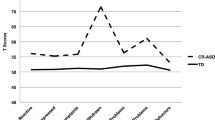Abstract.
In order to differentiate the behavioural profiles in autism and mental retardation and to cross-validate a behavioural autism screen, 84 subjects with autism (64 males and 20 females) with a mean age of 10 years selected from a Swiss national survey were compared to a control group of 84 subjects matched by age and gender with mental retardation, but without autistic features. The behavioural profile was assessed using the Developmental Behaviour Checklist (DBC). The behavioural profile in autism, in contrast to mental retardation, was marked by higher scores in the domains of disruptive, self-absorbed, communication disturbed, anxious and autistic behaviour, and a higher total DBC score. Furthermore, a higher vulnerability for behavioural abnormalities became evident for females with autism. A recently proposed DBC-Autism Screen was cross-validated, and a slight extension of the screen led to even higher correct classification rates. It was concluded that the DBC is a suitable instrument for the assessment of the behavioural profile and for screening in autism.
Similar content being viewed by others
References
Baron-Cohen S, Allen J, Gillberg C (1992) Can autism be detected at 18 months? The needle, the haystack, and the CHAT. Br J Psychiatry 161:839–843
Brereton A, Tonge B, Mackinnon A, Einfeld S (2002) Screening Young People for Autism with the Developmental Behaviour Checklist. J Am Acad Child Adolesc Psychiatry 41:1369–1375
Einfeld S, Tonge B (1992) Manual for the Developmental Behaviour Checklist. Primary Care Version (DBC-P). Australia: The University of New South Wales & Monash University
Einfeld S, Tonge B (1995) The Developmental Behaviour Checklist: the development and validation of an instrument to assess behavioural and emotional disturbance in children and adolescents with mental retardation. J Autism Dev Disord 25:81–104
Einfeld, S, Tonge B (1996a) Population prevalence of psychopathology in children and adolescents with intellectual disability: I Rationale and methods. J Intellect Dis Res 40:91–98
Einfeld S, Tonge B (1996b) Population prevalence of psychopathology in children and adolescents with intellectual disability: II. Epidemiological findings. J Intellect Dis Res 40:99–109
Einfeld S, Tonge B (July 1996) Personal Communication; Amendments to the Manual for the Developmental Behaviour Checklist. Primary Carer Version (DBC-P) 1996 Australia: The University of New South Wales & Monash University
Einfeld S, Tonge B (2002) Manual for the Developmental Behaviour Checklist (Second Edition) Australia: The University of New South Wales & Monash University
DiLavore P, Lord C, Rutter M (1995) The pre-linguistic autism diagnostic observation schedule. J Autism Dev Disord 25:355–379
Howlin P, Moore A (1997) Diagnosis in autism. Autism 1:135–162
Kazak Berument S, Rutter M, Lord C, Pickles A, Bailey A (1999) Autism screening questionnaire: diagnostic validity. Br J Psychiatry 175:444–451
Lord C, Pickles A, McLennan J, Rutter M, Bregman J, Folstein S, Fombonne E, Leboyer M, Minshew N (1997) Diagnosing Autism: Analyses of Data from the Autism Diagnostic Interview. J Autism Dev Disord 27:501–517
Lord C, Rutter M, Goode S, Heemsbergen J, Jordan H, Mawhood L, Schopler E (1989) Autism Diagnostic Observation Schedule: A standardized Observation of Communicative and Social Behaviour. J Autism Dev Disord 19:185–212
Luteijn E, Luteijn F, Jackson S, Volkmar F, Minderaa R (2000) The Children’s Social Behaviour Questionnaire for Milder Variants of PDD Problems: Evaluation of the Psychometric Characteristics. J Autism Dev Disord 30:317–330
Steinhausen HC, von Gontard A, Spohr HL, Hauffa B, Eiholzer U, Backes M, Willms J, Malin Z (2002) Behavioural Profiles in Four Mental Retardation Syndromes: Fetal Alcohol Syndrome, Prader-Willi Syndrome, Fragile X Syndrome, and Tuberosis Sclerosis. Am J Med Gen 111:381–387
Steinhausen HC, Willms J, Winkler Metzke C, Spohr HL (2003) Behavioural Profile in Fetal Alcohol Syndrome and Effects. Dev Med Child Neurol 45:179–182
Steinhausen HC (2004) Leben mit Autismus (Living with Autism), Bern, Huber Publisher
Wing L, Leekam S, Libby S, Gould J, Larcombe M (2002) The Diagnostic Interview for Social and Communication Disorders: background, inter-rater reliability and clinical use. J Child Psychol Psychiatry 43:307–325
Wing L (1981) Sex Ratios in Early Childhood Autism and Related Conditions. Psychiatry Res 5:129–137
Author information
Authors and Affiliations
Corresponding author
Rights and permissions
About this article
Cite this article
Steinhausen, HC., Winkler Metzke, C. Differentiating the behavioural profile in autism and mental retardation and testing of a screener. European Child & Adolescent Psychiatry 13, 214–220 (2004). https://doi.org/10.1007/s00787-004-0400-4
Accepted:
Issue Date:
DOI: https://doi.org/10.1007/s00787-004-0400-4



